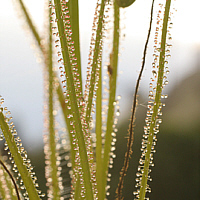Flypaper traps
Overview
The following genera use flypaper traps. Thereby the leaves of all genera show pediculated sticky glands (tentacles), which secrete a tough liquid. Chemically speaking this is a polysaccharide-solution (polysaccharide are multi-chain sugar molecules). With the polysaccharide-solution the insect of prey is on the one hand bottled up and on the other hand killed by agglutinating of the breath-openings of the chitinous exoskeleton. Already the sticky drops have a certain appeal with insects, these glisten under solar radiation, especially at the Portoguese Sundew these make in addition a pleasing reddish appearance. In addition an olfactoric attraction happens. Especially at the Portoguese Sundew this effect is distinctly to discern in the case of solar radiation. The plant exhale then an intensive, pleasant honey odour, which is not only for insects beguiling.
Furthermore can be distinguished between active and passive flypaper traps. The active flypaper traps are able to a movement of their tentacles and/or of the whole leaf, by contrast the passive flypaper traps are unable to this movement. The sundews and the butterworts belong to the active flypaper traps. Especially sundwes are able to distinct movements. At first the nearby tentacles edge their way because of chemical and tactile stimuli towards the prey, before possibly even the whole leaf lays itself around the prey and wraps this like a sandwich. In the case of butterworts the movement extent is distinct less. The tentacles are immovable, it simply takes place movements of the leaf. That means in the case of some species, that the leaf dents itself only slightly, whereby the insects swims in a small ‚lake full of mucus‘, however, some species can move their leaves to a greater extent and wrap the insect at least partially. To the passive flypaper traps belong the Portoguese Sundew, the Flycatcher Bush as well as the Rainbow Plant.
The utilisation of the prey proceeds by a secretion of digestive enzymes. Partly these are delivered by tentacles, partly by sessile glands. Thereby, the genera Byblis and Roridula constitute an exception. In both genera could so far no secretion of digestive enzymes be proven. Strictly speaking these genera are therefore only protocarnivorous plants. The genus Byblis is still classed by most authors as carnivorous plant, what is according to my opinion rather historical to justify. Substantial more interesting are the circumstances in the genus Roridula, which got involved with several bug and spider species in a close symbiosis and which profits from their excretions for the purpose of a leaf fertilization.

